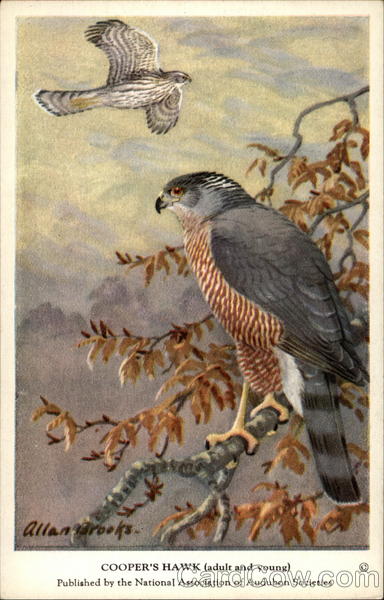Front:
allantarooks.
COOPER’S HAWK (adult and young)
Published by the National Association of Audubon Societies
Back:
No. 10 Cooper's Hawk
Length, male, 15 inches
The Cooper's Hawk, like its close relative, the
Sharp-shinned, is another of that very small num-
ber of birds whose destructive habits outweigh
the good they do. The species here described very
closely resembles the Sharp-shinned Hawk, but it
is larger and has a blackish crown. It also has a
well-rounded tail, whereas the tail of the Sharp-
shinned is square.
bined with its skillful hunting
above all, the real “Chicken Hawk
tryside. Its sudden sallies into
poultry yards are often the carpet of considerable
escape
34 contained poultry or game
birds; 52, otip birgs 11, mammals; 1, frogs; 3,
lizards ; 2, insects, and 39 were empty.” (Fisher.)
The nest of this Hawk is placed well up in trees.
The eggs are from three to six and are of a
pale bluish-white, sometimes faintly spotted with
brown.
The larger size of the Cooper's-Haus
ability, r804-
the coun-
IR
losses. Its swift and Maring attacks leave little
stomachs excitiaTON
fear and constepilatise wherever it goes. "Of 133
chance for the quadro.
Classification: Order Raptores. Family Buteonide.
Scientific name: Accipiter cooperi.
Range: Breeds from southern Canada, south to the
southern border of the United States. Winters through-
out much of its breeding range and as far south as
Costa Rica.
No. 10 from set of 50 Winter Birds of the Northeastern United
States. Published by the National Association of Audubon So-
cieties, 1974 Broadway, New York City. Price per set, in a box,
$1.00 post paid.



